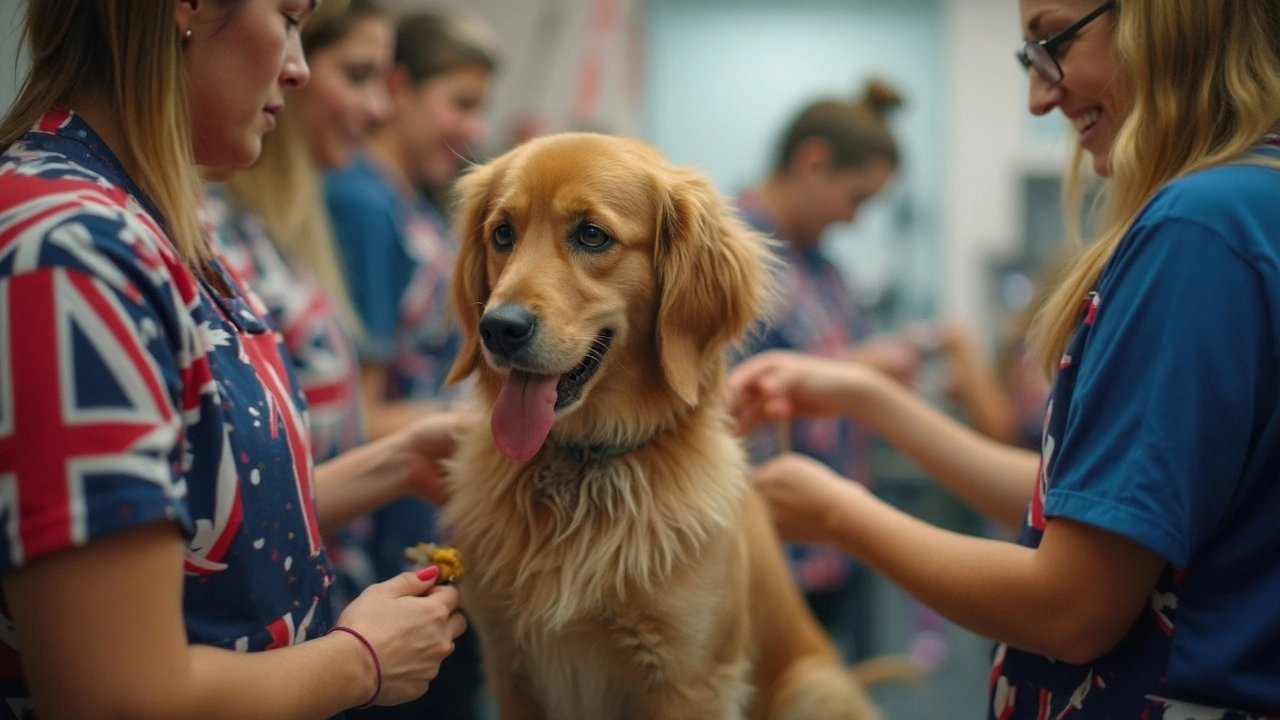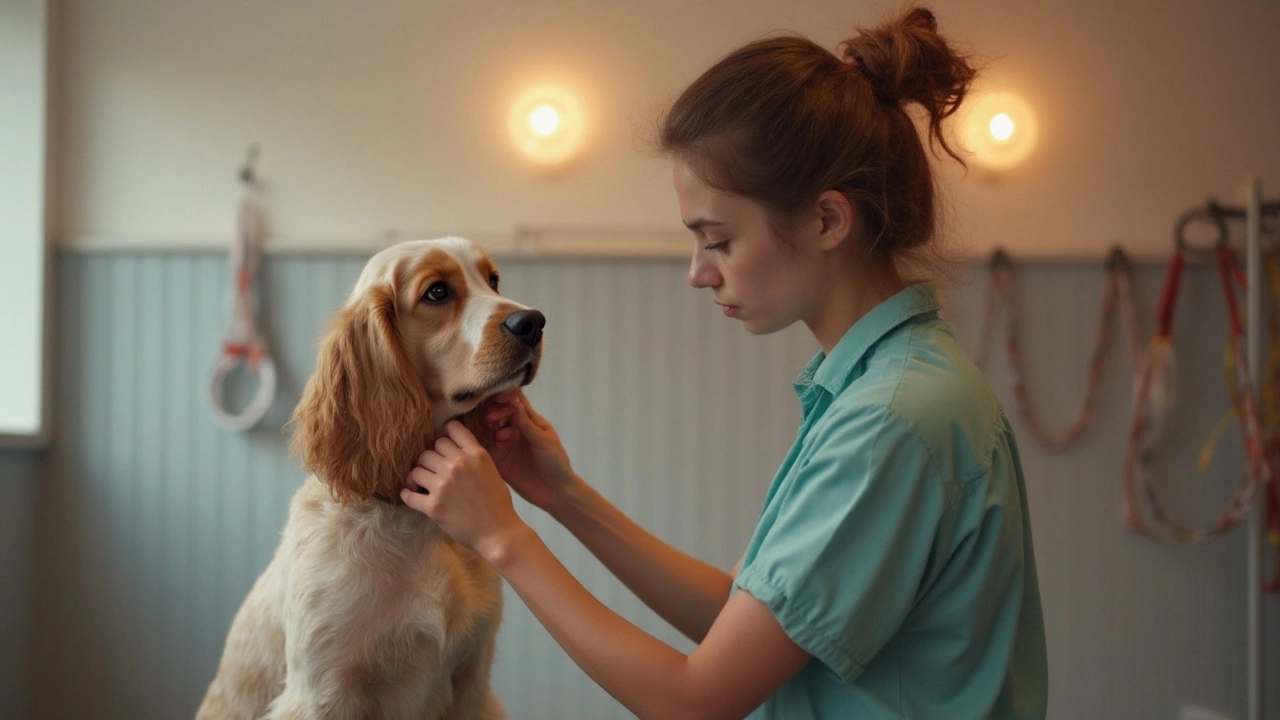You’ve probably seen those videos of squeaky-clean dogs at the groomer and thought—how do they keep those pups so still? It’s not magic, and definitely not brute force. Groomers have a whole routine for making sure dogs stay put, feel safe, and don’t squirm their way into danger during trims or washes.
The trick is using gentle restraints and calm, clear communication the whole time. It’s way more about reducing stress for the dog than just getting the job done fast. The goal? Keep the pup safe and the experience as chill as possible. If you’ve got a wriggly dog at home, you’re about to pick up some tricks of the trade—even if you’re just trimming nails in your own bathroom.
- Why Restraint Matters in Dog Grooming
- Gentle Tools Pros Use
- Handling Nervous or Wiggly Dogs
- Do’s and Don’ts for Safety
- Tips for Owners with Anxious Pups
Why Restraint Matters in Dog Grooming
Restraint isn’t about controlling a dog just for the sake of it—it’s all about safety. Imagine trying to snip hair or trim nails while your dog does zoomies on the table. One sudden move and things can go wrong fast. That’s why groomers put a big focus on using smart restraint methods to keep everyone safe—dogs, groomers, and anyone else in the room.
Grooming tools, like clippers or nail trimmers, are sharp. Even the friendliest dogs can get spooked by buzzing or slippery water. Good restraint stops the dog from jumping off the table or jerking suddenly, making it far less likely anyone gets hurt.
Some dogs get anxious or afraid during grooming, especially if they’ve had a bad experience. Proper restraint actually helps anxious dogs settle down, because they can’t panic and dash off. A study in 2021 found that most injuries to dogs during grooming happened because the dog moved unexpectedly or wasn’t held securely. Only a small percentage of injuries were from the tools themselves.
| Reason | Why It Matters |
|---|---|
| Dog Safety | Prevents falls and tool injuries |
| Groomer Safety | Stops bites, scratches, and accidents |
| Less Stress | Keeps the grooming time short and calm |
If you’re worried about your own dog, know that dog grooming isn’t about forcing a pup into stillness. It’s about using the right techniques so your dog feels comfy, less scared, and way safer—whether it’s a trip to the groomer or a DIY spa day at home.
Gentle Tools Pros Use
Walk into any grooming salon and you’ll spot a whole range of gear designed to keep dogs safe and comfy—not stressed out. It’s not just about putting a loop around a pup’s neck and hoping for the best. Groomers match their tools to the size, personality, and wiggle level of each dog.
Dog grooming tables usually come fitted with an adjustable arm and a soft, padded noose or loop. This isn’t as intense as it looks—the loop’s there just to prevent jumping or sudden turns, keeping things predictable for both dog and groomer. Most loops are covered in nylon or soft fabric to avoid chafing. Plus, pros can adjust the height so the dog’s not dangling or stressed.
For smaller dogs or pups with neck issues, groomers might use a belly sling or hammock. The sling supports the dog’s body underneath, making it easier to trim nails or clean up tricky spots without too much fidgeting. Some salons have non-slip mats on their tables, so even nervous dogs feel a bit more grounded.
Nail trims are a special case. Sometimes dogs panic if you hold their paws too tightly. That’s when groomers use gentle "hug" holds, or even little mesh muzzles—not to punish, just to keep everyone safe from accidental nips. Big breeds sometimes get a special grooming harness with wide, supportive straps that won’t pinch or pull fur.
"A good restraint tool is one a dog almost forgets about once work starts. If the dog’s relaxed, you know you’re using the right technique." — Megan Weigel, Certified Master Groomer
Here’s a quick snapshot of common restraint tools and how they’re used:
| Tool | Best for | Main Benefit |
|---|---|---|
| Grooming Loop | Most breeds | Prevents sudden jumps or falls |
| Belly Sling | Small dogs, older dogs | Supports body gently for steadying |
| Non-Slip Mat | Anxious or elderly pups | Less sliding, more comfort |
| Muzzle | Nippy dogs | Keeps everyone safe, lowers risk |
| Harness | Large or strong breeds | Even weight support, less neck strain |
These aren’t scary tools when used right—they’re there to make grooming quick, calm, and safe. If your groomer ever pulls out a new gadget, just ask about it. Most are designed to work with a dog’s body, not against it.

Handling Nervous or Wiggly Dogs
Nervous or hyper dogs can make dog grooming a challenge, but pro groomers have a toolkit of tips to calm the chaos. A big part of the job is reading the dog's body language before things even get started. Yawning, lip licking, or tucking the tail? That’s your sign the pup’s not thrilled and needs some extra patience.
Most groomers start slow, letting the dog sniff the tools and table. Sometimes, just turning on clippers for a second so the dog can get used to the sound actually helps. Treats are gold for building trust, and lots of groomers keep a pocket full of tiny, chewy snacks for nervous newcomers.
For wigglers, keeping a hand on the pup’s body or talking to them quietly helps a lot. Gentle restraint tools—like nooses with padding or safety straps—are there to keep dogs from making a leap off the table, not to pin them down tight. If a dog freaks out, groomers usually pause, give them a break, or even let them stretch on the floor for a minute before trying again.
- Short grooming sessions can help anxious dogs get used to the process gradually.
- Many groomers use calming sprays or pheromone diffusers to create a chill space.
- If dogs are extremely anxious, vets might recommend mild sedatives, but this is always the last resort and only with owner permission.
If you know your dog gets stressed, tell your groomer. Some places even book extra time or schedule nervous dogs during slow hours so it’s less overwhelming. Comfort items, like a favorite toy or blanket, can also go a long way. The bottom line: patience and empathy do more for scared dogs than any special equipment ever could.
Do’s and Don’ts for Safety
Safety keeps both the groomer and the pup out of trouble, but it’s easy to mess up if you don’t follow some clear do’s and don’ts. Ignoring safety for the sake of speed or convenience is how accidents happen. Here’s what groomers and owners need to remember:
- Dog grooming sessions should always start calm—sudden loud noises or grabbing at a dog can ramp up anxiety.
- Use safety loops, harnesses, or non-slip mats, but check that nothing is too tight. You should easily fit two fingers under a loop around the neck.
- Keep tools and chemicals far from reach—one unexpected lunge and a bottle of shampoo could go flying, or worse, into a dog’s mouth.
- Never leave a dog unattended on a table, not even for a second. That’s how nasty falls happen.
- Give nervous dogs regular breaks, especially if they’re showing big stress signals like lip-licking, panting, or yawning nonstop.
Avoid these common slip-ups:
- Don’t use muzzles or restraints as punishment. They’re only for safety, not discipline.
- Never tie a dog to a fixed object by the leash—if they panic, they could seriously hurt their neck or spine.
- Don’t ignore the signs. If a dog’s growling, shaking, or cowering, pressing ahead just makes the next groom even harder.
- Skip shortcuts like holding a dog too firmly by the scruff or using old, broken restraint gear. These can lead to injuries or more fear.
Here’s a quick snapshot of injuries in dog grooming and where they happen most:
| Type of Injury | Most Common Cause | % of Reported Incidents |
|---|---|---|
| Falls from table | Left unattended | 35% |
| Cuts/Nicks | Poor control or dull tools | 28% |
| Choking incidents | Improper loop use | 14% |
Small changes mean big boosts to safety. Always double-check your gear and your grip, and keep a calm, watchful eye—even with “easy” dogs. It’s just not worth the risk.

Tips for Owners with Anxious Pups
If your dog gets nervous at the groomer, you’re definitely not alone. Loads of dogs feel uneasy with all the buzzers, water, and new smells. Pro groomers see it every single day. Around 50% of pet parents say their dog struggles with grooming anxiety, according to a 2023 North American Pet Care Survey.
Here’s what you can actually do to make things easier for your pup—and for yourself:
- dog grooming is smoother when you start with at-home desensitizing. Try gently touching your dog’s paws, ears, and tail every day. Give treats and keep sessions short so your dog learns it’s no big deal.
- Bring a favorite toy or blanket to the salon. Familiar smells can work wonders for scared dogs.
- Ask the groomer if you can do short intro visits—maybe just popping in for a few treats and a brush without a full groom. Lots of salons are super open to this.
- Try mood-soothers like a Thundershirt or a calming pheromone spray. These won’t fix everything, but they can take the edge off for some dogs.
- Don’t feed a huge meal right before the appointment. A slightly hungry pup is less likely to feel queasy or have an accident.
- Mention your dog’s anxieties when you book. Any groomer worth their salt wants the heads-up so they can plan shorter sessions, extra cuddles, or extra staff support if needed.
Ever wondered how effective these tips really are? Here’s a snapshot from a 2024 Pet Wellness Survey about what helped anxious dogs calm down at the groomer:
| Technique | % Owners Reporting Success |
|---|---|
| Short intro visits | 44% |
| Favorite blanket/toy | 36% |
| Daily at-home touch practice | 53% |
| Calming sprays/shirts | 27% |
If your dog is really panicking, talk to your vet. Sometimes, anti-anxiety meds or a dog behaviorist can help turn those grooming nightmares into just another part of the week. No shame in asking for help—groomers appreciate it, too.

